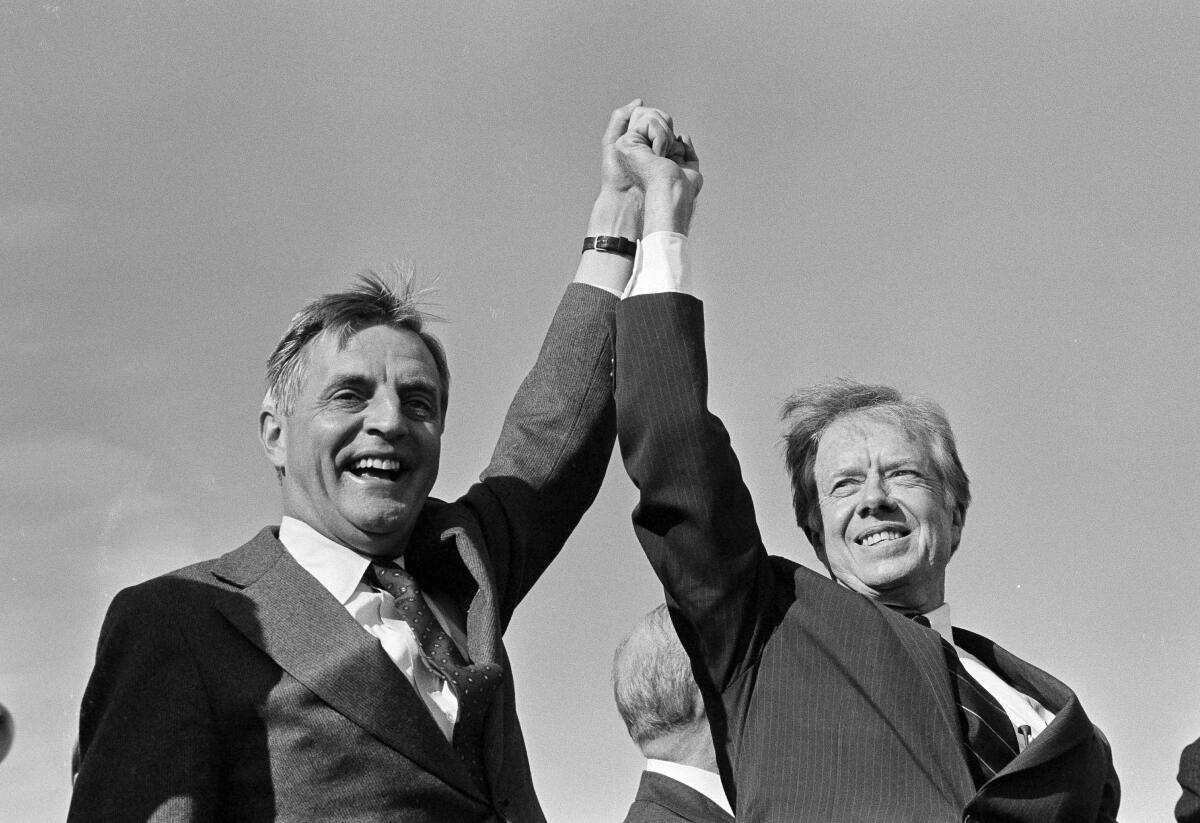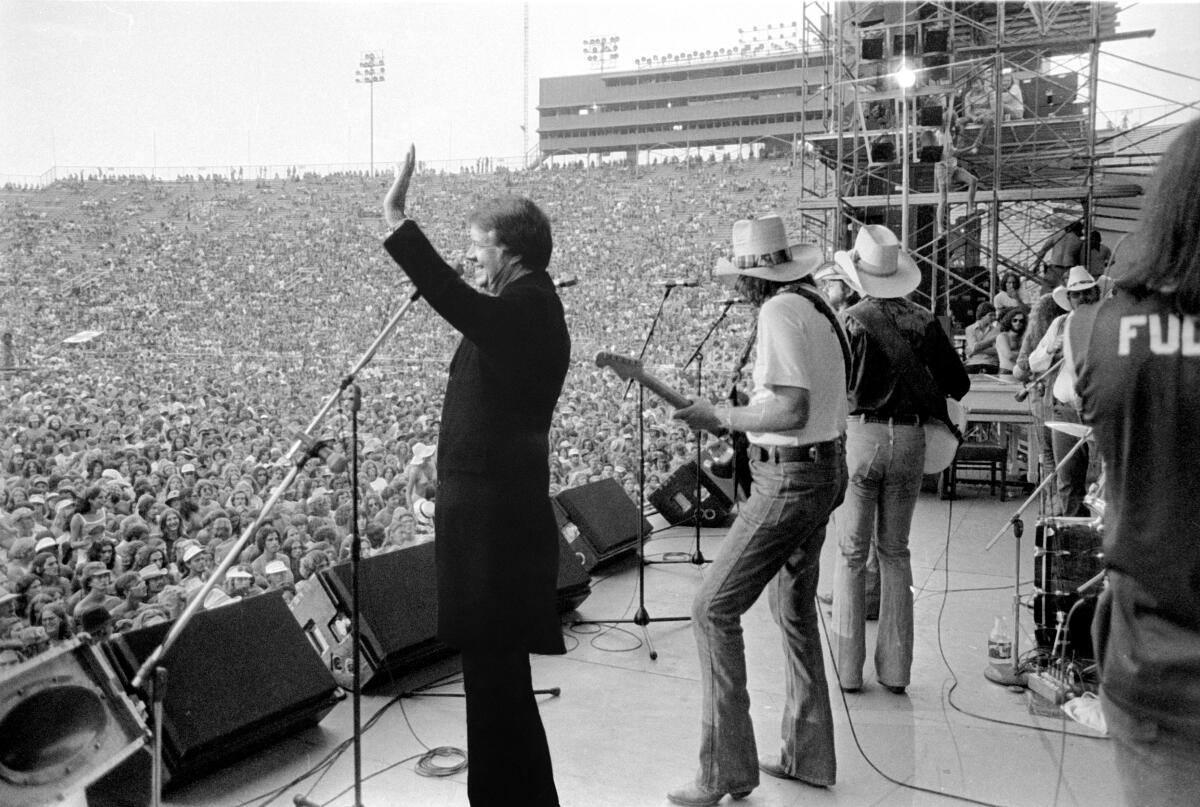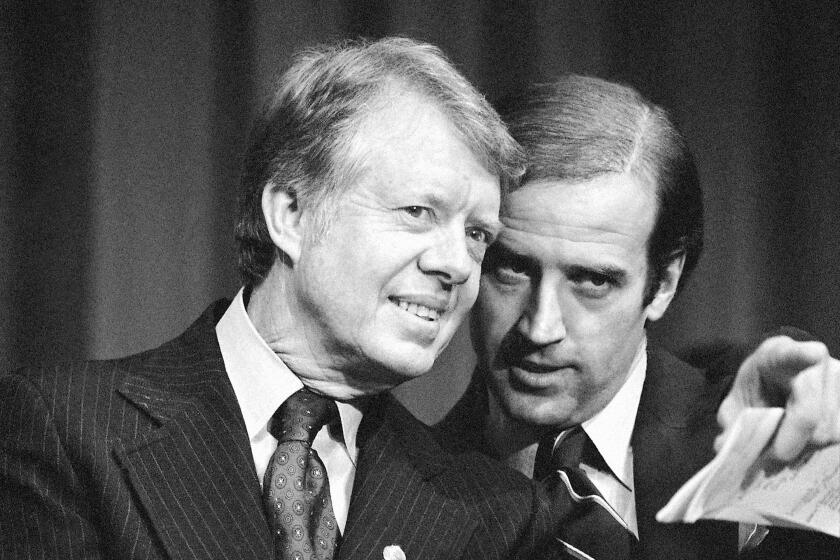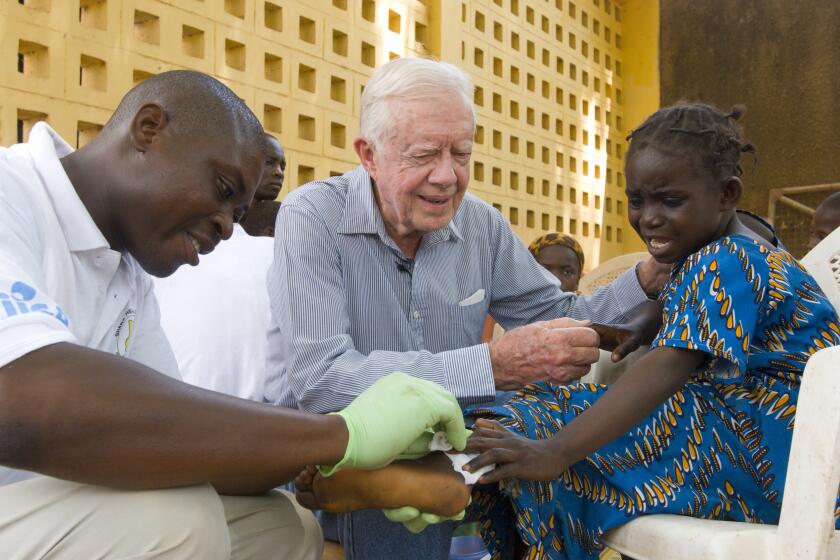Jimmy Carter, nation’s 39th president who became influential human rights advocate, dies

- Share via
Jimmy Carter, a peanut farmer and little-known Georgia governor who became the 39th president of the United States, promising “honest and decent” government to Watergate-weary Americans, and later returned to the world stage as an influential human rights advocate and Nobel Peace Prize winner, has died.
He was 100.
When his turbulent presidency ended after a stinging reelection loss in 1980, Carter retreated to Plains, his political career over. Over the four decades that followed, though, he forged a legacy of public service, building homes for the needy, monitoring elections around the globe and emerging as a fearless and sometimes controversial critic of governments that mistreated their citizens.
He lived longer than any U.S. president in history and was still regularly teaching Bible classes at his hometown Maranatha Baptist Church well into his 90s. During his post-presidency, he also wrote more than 30 books, including fiction, poetry, deeply personal reflections on his faith, and commentaries on Middle East strife.
Though slowed by battles with melanoma that spread to his brain and liver, and a series of falls and hip replacement in recent years, he returned again and again to his charity work and continued to offer occasional political commentary, including in support of mail-in voting ahead of the 2020 presidential election.

Carter was in his first term as Georgia governor when he launched his campaign to unseat President Ford in the 1976 election. At the time, the nation was still shaken by President Nixon’s resignation in the Watergate scandal and by the messy end of the Vietnam War. As a moderate Southern Democrat, a standard-bearer of what was then regarded as a more racially tolerant “new South,” Carter promised a government “as good and honest and decent and competent and compassionate and as filled with love as are the American people.”
But some of the traits that had helped get Carter elected — his willingness to take on the Washington establishment and his preference for practicality over ideology — didn’t serve him as well in the White House. He showed a deep understanding of policy, and a refreshing modesty and disregard for the ceremonial trappings of the office, but he was unable to make the legislative deals expected of a president.
Even though his Democratic Party had a majority in Congress throughout his presidency, he was impatient with the legislative give-and-take and struggled to mobilize party leaders behind his policy initiatives. His presidency also was buffeted by domestic crises — rampant inflation and high unemployment, as well as interminable lines at gas stations triggered by a decline in the global oil supply exacerbated by Iran’s Islamic Revolution.

“Looking back, I am struck by how many unpopular objectives we pursued,” Carter acknowledged in his 2010 book, “White House Diary.”
“I was sometimes accused of ‘micromanaging’ the affairs of government and being excessively autocratic,” he continued, “and I must admit that my critics probably had a valid point.”
Carter’s signature achievements as president were primarily on the international front, and included personally brokering the Camp David peace accords between Egypt and Israel, which have endured for more than 40 years.
But it was another international crisis — the storming of the U.S. Embassy in Tehran by Iranian revolutionaries and the government’s inability to win the release of 52 Americans taken hostage — that would cast a long shadow on his presidency and his bid for reelection.
Carter authorized a secret military mission to rescue the hostages in April 1980, but it was aborted at the desert staging area; during the withdrawal, eight servicemen were killed when a helicopter crashed into a transport aircraft. The hostages were held for 444 days, a period that spanned Carter’s final 15 months in the White House. They were finally freed the day his successor, Ronald Reagan, took the oath of office.

Near the end of Carter’s presidency, one poll put his job approval rating at 21% — lower than Nixon’s when he resigned in disgrace and among the lowest of any White House occupant since World War II.
In a rarity for an incumbent president, Carter faced a formidable primary challenge in 1980 from Sen. Edward M. Kennedy, a favorite of the Democratic Party’s liberal wing. Although Carter prevailed, his nomination was in doubt until the party’s August convention.
The enmity between Carter and Kennedy, two of the most important Democratic political figures of their generation, continued throughout their lives. In Kennedy’s memoir, published shortly after his death in 2009, he called Carter petty and guilty of “a failure to listen.” While promoting the publication of “White House Diary,” Carter said Kennedy had “deliberately” blocked Carter’s comprehensive healthcare proposals in the late 1970s in hopes of defeating the president in the primary.
In the 1980 general election, Carter faced Reagan, then 69, who campaigned on a promise to increase military spending and rescue the economy by cutting taxes and decreasing regulation. Carter lost in a 51% to 41% thumping — he won just six states and the District of Columbia — that devastated the man known for his toothy smile and sent him back to his hometown, an ex-president at 56.
Jimmy Carter was a shrewd and sometimes ruthless politician until he was elected president. Then he changed his style.
A year later, he and his wife Rosalynn founded the Carter Center, which pressed for peaceful solutions to world conflicts, promoted human rights and worked to eradicate disease in the poorest nations. The center, based in Atlanta, launched a new phase of Carter’s public life, one that would move the same historians who called Carter a weak president to label him one of America’s greatest former leaders.
His post-presidential years were both “historic and polarizing,” as Princeton University historian Julian E. Zelizer put it in a 2010 biography of Carter. Zelizer said Carter “refused to be constrained politically when pursuing his international agenda” as an ex-president, and became “an enormously powerful figure on the international stage.”
When Carter appeared on “The Colbert Report” in 2014, host Stephen Colbert asked him, “You invented the idea of the post-presidency. What inspired you to do that?”
“I didn’t have anything else to do,” Carter replied.

He traveled widely to mediate conflicts and monitor elections around the world, joined Habitat for Humanity to promote “sweat equity” for low-income homeownership, and became a blunt critic of human rights abuses. He angered conservatives and some liberals by advocating negotiations with autocrats — and his criticism of Israeli leaders and support for Palestinian self-determination angered many Jews.
A prolific author, Carter covered a range of topics, including the Middle East crisis and the virtues of aging and religion. He penned a memoir on growing up in the rural South as well as a book of poems, and he was the first president to write a novel — “The Hornet’s Nest,” about the South during the Revolutionary War. He won three Grammy Awards as well for best spoken-word album, most recently in 2019 for “Faith: A Journey For All.”
As with many former presidents, Carter’s popularity rose in the years after he left office. He was awarded the Nobel Peace Prize in 2002 for “decades of untiring effort to find peaceful solutions to international conflicts” and to advance democracy and human rights. By then, two-thirds of Americans said they approved of his presidency.
“Jimmy Carter may never be rated a great president,” wrote Charles O. Jones, a University of Wisconsin political scientist, in his chronicle of the Carter presidency. “Yet it will be difficult in the long run to sustain censure of a president motivated to do what is right.”
The journey for James Earl Carter Jr. began on Oct. 1, 1924, in the tiny Sumter County, Ga., town of Plains, home to fewer than 600 people in 2020. He was the first president born in a hospital, but he lived in a house without electricity or indoor plumbing until he was a teenager. His ancestors had been in Georgia for more than two centuries, and he was the fifth generation to own and farm the same land.
His father, James Earl Carter Sr., known as Mr. Earl, was a strict disciplinarian and a conservative businessman of some means. His mother, known as Miss Lillian, had more liberal views — she was known for her charity work and for taking in transients and treating Black residents with kindness. (At the age of 70, she joined the Peace Corps, working in India.)
Inspired by an uncle who was in the Navy, Carter decided as a first-grader that he wanted to go to the Naval Academy in Annapolis, Md. He became the first member of his family to finish high school, then attended Georgia Tech before heading for the academy, where he studied engineering and graduated in 1946, 59th in a class of 820.
Before his last year in Annapolis, while home for the summer, he met Eleanor Rosalynn Smith, a friend of his sister Ruth’s. He and a friend invited the two young women to the movies, and when he returned home that night, he told his mother he had met “the girl I want to marry.” He proposed that Christmas, but Rosalynn declined because she felt she was too young (she was 18 and a sophomore in college). Several weeks later, while she was visiting Carter at the academy, he asked again. This time she said yes.

Carter applied to America’s new nuclear-powered submarine program under the command of the icy and demanding Capt. (later Adm.) Hyman Rickover. During Carter’s interview, Rickover asked whether he had done his best at Annapolis.
“I started to say, ‘Yes, sir,’ but … I recalled several of the many times at the Academy when I could have learned more about our allies, our enemies, weapons, strategy and so forth,” Carter wrote in his autobiography. “... I finally gulped and said, ‘No, sir, I didn’t always do my best.’” To which Rickover replied: “Why not?”
Carter got the job, and would later make “Why not the best?” his campaign slogan.
The Carters had three sons, who all go by nicknames — John William, “Jack”; James Earl, “Chip”; and Donnel Jeffrey, “Jeff.” Carter and Rosalynn had wanted to have more children, but an obstetrician said that surgery Rosalynn had to remove a tumor on her uterus would make that impossible. Fifteen years after Jeffrey was born, the Carters had a daughter, Amy, who “made us young again,” Carter would later write.
While in the Navy, Carter took graduate courses in nuclear physics and served as a submariner on the USS Pomfret. But his military career was cut short when his father died, and he moved back to Georgia in 1953 to help run the family business, which was in disarray.

In his first year back on the farm, Carter turned a profit of less than $200, the equivalent of about $2,200 today. But with Rosalynn’s help, he expanded the business. In addition to farming 3,100 acres, the family soon operated a seed and fertilizer business, warehouses, a peanut-shelling plant and a cotton gin. By the time he began his campaign for the White House 20 years later, Carter had a net worth of about $800,000, and the revenue from his enterprises was more than $2 million a year.
Carter entered electoral politics in 1962, and asked voters to call him “Jimmy.” He ran for a seat in the Georgia Senate against an incumbent backed by a local political boss who stuffed the ballot box. Trailing by 139 votes after the primary, Carter waged a furious legal battle, which he described years later in his book “Turning Point.” Carter got a recount, the primary result was reversed, and he went on to win the general election.
The victory was a defining moment for Carter, the outsider committed to fairness and honesty who had successfully battled establishment politicians corrupted by their ties to special interests.
At a transitional moment in U.S. history, President Carter opted to emphasize human rights in U.S. foreign policy, shaking up the establishment and altering the conversation ever since.
In two terms in the Georgia Senate, Carter established a legislative record that was socially progressive and fiscally conservative. He first ran for governor in 1966, but finished third in the primary. Over the next four years, he made 1,800 speeches and shook hands with an estimated 600,000 people — a style of campaigning that paid off in the 1970 gubernatorial election and later in his bid for the White House.
In his inaugural address as governor in 1971, Carter made national news by declaring that “the time for racial discrimination is over.” He had a portrait of the Rev. Martin Luther King Jr. hung in a hall at the Capitol in Atlanta.

But when Carter launched his official campaign for the White House in December 1974, he was still so little-known outside Georgia that a celebrity panel on the TV show “What’s My Line?” couldn’t identify him.
In the beginning, many scoffed at the temerity of a peanut farmer and one-term governor running for the highest office in the land. After Carter met with House Speaker Thomas P. “Tip” O’Neill Jr., the speaker was asked whom he had been talking to. “Some fellow named Jimmy Carter from Georgia. Says he’s running for president,” O’Neill replied.
In a meeting with editors of the Los Angeles Times in 1975, Carter said he planned to gain the presidency by building a network of supporters and by giving his candidacy an early boost by winning the Iowa caucuses. Until then, Iowa had been a bit player in the nominating process, mostly ignored by strategists. But Carter’s victory there vaulted him to front-runner status — and Iowa into a major role in presidential nominations.
One of former President Carter’s biggest hopes is wiping out an infectious parasitic disease that’s plagued humans for millennia. How close is he?
His emergence from the pack of Democratic hopefuls was helped by the release of his well-reviewed autobiography “Why Not the Best?” in which he described his upbringing on the farm and his traditional moral values.
On the campaign trail, Carter came across as refreshingly candid and even innocent — an antidote to the atmosphere of scandal that had eroded confidence in public officials since the events leading to Nixon’s resignation on Aug. 9, 1974.
A Baptist Sunday school teacher, Carter was among the first presidential candidates to embrace the label of born-again Christian. That was underscored when, in an interview with Playboy magazine, he made headlines by admitting, “I’ve looked on many women with lust. I’ve committed adultery in my heart many times. God knows I will do this and forgives me.”
Carter had emerged from the Democratic National Convention in July with a wide lead over Ford, Nixon’s vice president and successor, but by the time of the Playboy interview in September, his numbers were tumbling. By election day, the contest was a dead heat. Carter, running on a ticket with Walter F. Mondale for his vice president, eked out a victory with one of the narrower margins in U.S. presidential history, winning 50.1% to 48% of the popular vote and 297 electoral votes, 27 more than needed.
A new documentary, “Jimmy Carter: Rock & Roll President,” examines the former POTUS’ relationships with icons such as Willie Nelson, Bob Dylan and Gregg Allman.
Many of Carter’s supporters hoped he would usher in a new era of liberal policies. But he saw his role as more of a problem-solver than a politician, and as an outsider who promised to shake things up in Washington, he often acted unilaterally.
A few weeks into his term, Carter announced that he was cutting off federal funding to 18 water projects around the country to save money and protect the environment. Lawmakers, surprised by the assault on their pet projects, were livid.
He ultimately backed down on some of the cuts. But his relationship with Congress never fully healed. Members often complained that they couldn’t get in to see him, and that when they did he was in a rush to show them the door. His relationship with the media, as he acknowledged later in life, was similarly fraught.
Carter’s image as a reformer also took a hit early in his presidency after he appointed Bert Lance, a longtime confidant, to head the Office of Management and Budget. Within months of the appointment, questions were raised about Lance’s personal financial affairs as a Georgia banker.
Adamant that Lance had done nothing wrong, Carter dug in his heels and publicly told his friend, “Bert, I’m proud of you.” Still, Lance resigned under pressure, and although he was later acquitted of criminal charges, the damage to Carter had been done. As Mondale later put it: “It made people realize that we were no different than anybody else.”
When Carter did score legislative victories, the cost was high. In 1978, he pushed the Senate to ratify the Panama Canal treaties to eventually hand control of the canal over to Panama. But conservatives criticized the move as a diminution of U.S. strength, and even the Democratic National Committee declined to endorse it.
Carter’s most significant foreign policy accomplishment was the 1978 Camp David agreement, a peace pact between Israel and Egypt. But he followed that with several unpopular moves, including his decree that the United States would not participate in the 1980 Summer Olympics in Moscow, as a protest against the Soviet Union’s invasion of Afghanistan. It was the only time in Olympic history that the United States had boycotted an Olympics; the Soviets responded by boycotting the 1984 Summer Games in Los Angeles.

Carter had taken a series of largely symbolic steps to dispel the imperial image of the presidency. After he took the oath of office on a wintry day, he and the new first lady emerged from their motorcade and walked part of the way from the Capitol to the White House.
He ended chauffeur-driven cars for top staff members, sold the presidential yacht, went to the White House mess hall for lunch with the staff and conducted town meetings around the country. He suspended the playing of “Hail to the Chief” whenever he arrived at an event, though he later allowed the practice to resume.
On the domestic front, he was saddled with a country in crisis. Inflation galloped at rates up to 14%, and global gasoline shortages closed service stations and created high prices and long lines. Interest rates for home mortgages soared above 14%.
In his first televised fireside chat, he wore a cardigan sweater and encouraged Americans to conserve energy during the winter by keeping their thermostats at 65 degrees in the daytime and 55 degrees at night. He also proposed a string of legislative initiatives to deal with the crisis, but many were blocked by Congress.
Putting to rest differences over an interview that came to cause Jimmy Carter discomfort.
In what would become a seminal moment in his presidency, Carter addressed the nation — and a television audience of more than 60 million — on a Sunday evening in 1979, saying the country had been seized by a “crisis of confidence … that strikes at the very heart and soul and spirit of our national will.” He outlined a series of proposals to develop new sources of energy.
The address, widely known as the “malaise speech” even though Carter never used that word, was generally well-received at the time, though some bristled at the implication that Americans were to blame for the country’s problems. Any positive glow disappeared two days later, when Carter fired five of his top officials, including the Energy, Treasury and Transportation secretaries and his attorney general. The value of the dollar sank and the stock market tumbled.
Sensing that Carter was politically vulnerable, Kennedy moved to present himself as an alternative for the 1980 Democratic nomination, publicly criticizing the president’s agenda. But Kennedy damaged his own candidacy in a prime-time interview with CBS’ Roger Mudd: Asked why he was running for president, Kennedy fumbled his answer, and critics cited it as evidence that the senator didn’t want the job so much as he felt obligated to seek it.

A few months after the malaise speech, in late 1979, revolutionaries loyal to Iran’s spiritual leader, the Ayatollah Ruhollah Khomeini, seized the U.S. Embassy in Tehran, taking 52 Americans hostage. Weeks stretched into months, with Iran refusing all efforts to negotiate a hostage release.
In April 1980, Carter approved Operation Eagle Claw, a secret Delta Force rescue mission. But it ended in disaster — mechanical trouble sidelined three helicopters and, after the mission was aborted, one of the remaining helicopters collided with a transport plane on the ground, killing eight soldiers. Secretary of State Cyrus R. Vance resigned before the mission, believing the plan too risky.
Negotiations to free the hostages resumed, and Carter desperately tried to win their release before the November election. But the Iranians prolonged the talks and the hostages weren’t released until Jan. 20, 1981, moments after Carter watched Reagan being sworn in.
The journey home for Carter was painful. Of those who voted for Reagan in 1980, nearly 1 in 4 said they were primarily motivated by their dissatisfaction with Carter.
Carter faced “an altogether new, unwanted and potentially empty life,” as he later put it. He sold the family farm-supply business, which had been placed in a blind trust during his presidency and was by then deeply in debt.
Then, as Rosalynn later recalled, Carter awoke one night with an idea to build not just a presidential library but a place to resolve global conflicts. Together, they founded the nonprofit, nonpartisan Carter Center.
His skill as a mediator made Carter a ready choice for future presidents seeking envoys to navigate crises. Republican President George H.W. Bush sent him on peace missions to Ethiopia and Sudan, and President Clinton, a fellow Democrat, dispatched him to North Korea, Haiti and what then was Yugoslavia.
One of former President Carter’s biggest hopes is wiping out an infectious parasitic disease that’s plagued humans for millennia. How close is he?
Carter described his relationship with President Obama as chilly, however, in part because he had openly criticized the administration’s policies toward Israel. He felt Obama did not strongly enough support a separate Palestinian state. “Every president has been a very powerful factor here in advocating this two-state solution,” Carter told the New York Times in 2012. “That is now not apparent.”
As an election observer, he called them as he saw them. After monitoring presidential voting in Panama in 1989, he declared that Manuel Noriega had rigged the election. He also began building houses worldwide for Habitat for Humanity, and he wrote prodigiously.
The Nobel committee awarded Carter the Peace Prize in 2002, more than two decades after he left the White House, praising him for standing by “the principles that conflicts must as far as possible be resolved through mediation and international cooperation.”
During his 70s, 80s and even into his 90s, the former president showed an energy that never failed to impress those around him. In his 1998 book “The Virtues of Aging,” he urged retirees to remain active and engaged, and he followed his own advice, continuing to jog, play tennis and go fly-fishing well into his 80s. When his “White House Diary” was published in 2010, he embarked on a nationwide book tour at 85, as he did in 2015 with the publication of “A Full Life: Reflections at 90.”

When he told America he had cancer that had spread to his liver and brain, it was vintage Carter. Wearing a coat and tie and a pair of blue jeans, he stared into the television cameras and was unflinchingly blunt about his prognosis.
“Hope for the best; accept what comes,” he said. “I think I have been as blessed as any human being in the world.”
Former Times staff writers Jack Nelson, Robert Shogan and Johanna Neuman contributed to this report.










